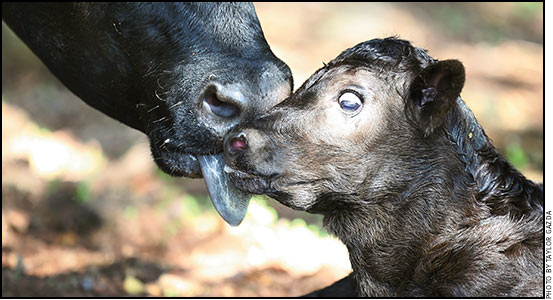MANAGEMENT...

Bonding Tips
Once in a while, a first-calf heifer may need assistance in jump-starting her mothering instincts.
A first-calf heifer may act confused or indifferent toward her newborn calf. She may continue to lie there and not get up to lick the calf. When she finally does, she may seem surprised to see this strange new wiggling creature. The heifer may walk away, ignoring it, or she may kick the calf when it gets up and staggers toward her. Some heifers attack the calf if it tries to get up.
If you had to pull a heifer’s calf, this may disrupt the normal bonding process. If you take a cold newborn to the barn to warm and dry it before its mother has a chance to lick it, this may also disrupt bonding.
“One technique that helps facilitate proper maternal response is smearing birth fluids across the muzzle and tongue of the dam following an assisted delivery,” says Joseph Stookey, professor of animal behavior at the Western College of Veterinary Medicine, Saskatoon, Sask. Read more.
Capturing Pounds and Profits
Beef cattle producers should seek every pound of gain possible.
In a high or low cattle market environment, capturing the most pounds per calf affects a producer’s bottom line, said a Texas A&M AgriLife Extension Service economist.
Mac Young, AgriLife Extension economist in Corpus Christi, told attendees at the recent Texas and Southwestern Cattle Raisers Association (TSCRA) convention in Fort Worth that beef producers have obviously enjoyed the record-high prices they’ve received the past couple of years.
However, purchasing replacement females has been an expensive proposition, he said.
“Prices for 2016 are obviously higher than 2012. That’s great if you are selling, but not so great if you are buying replacement heifers or cows,” he said. “We’ve seen those record-high prices come down a bit since late last year and you need to do everything you can to put as many pounds on your calves as possible.” Read more.
Fly Season Accelerating
Cattle producers should protect their animals as fly season accelerates.
Springtime conditions are increasing fly activity, and cattle producers should take steps to protect animals and reduce losses, said Jason Banta, Texas A&M AgriLife Extension Service beef cattle specialist at Overton.
Horn flies, stable flies and house flies are the most common fly pests in Texas. Flies may be viewed by some as a nuisance to their animals, but they also cost cattle producers statewide hundreds of millions of dollars each year.
Banta said ranchers should be extra wary of horn and stable flies. The economic impact of the two species can cost a rancher more than $10 per calf in a 100-day period.
Read more.
New Products
Industry affiliates provide a wide array of products and services to assist you on the farm and ranch. Here’s an assortment of new products to hit the market recently.
- Smaller supplement tub
- Early pregnancy detection
- Fetal development
- Water conservation agent
- Cellular machine guidance
- Free video instruction

Kris Ringwall
Beef Talk
The key to managing drought is good cattle sorting
and modified stocking rates.
A critical part of cow herd management is knowing the typical cow herd is made up of five subunits: 20% replacement heifers, 15% first-calf heifers, 5% dry cows, 10% dysfunctional or older cows, and 50% mature cows.
A cow is not just a cow. Each cow belongs to a subunit. Get familiar with these subunits, because each one has a different potential for profit and herd longevity.
This spring, like many, has the potential to give way to a dry summer. Read more.
Wildfire Effects On Various Grasses
A K-State range management specialist offers pasture management advice to producers.
The recent wildfires that have popped up throughout parts of Kansas and Oklahoma may have producers wondering how to properly manage pastureland following these wildfires, some of which have been disastrous.
Walter Fick, professor in the Kansas State University (K-State) Department of Agronomy, said it’s hard to lump all the wildfires together and how pastures might respond. Each fire could have somewhat different effects. Read more.
Angus Advisor
Click here for May herd management tips from cattle experts across the nation. Advice separated by region.
[Click here to go to the top of the page.]






